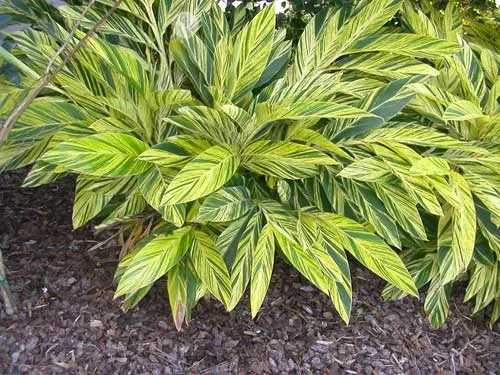Warning: Flowering bulbs may be toxic if consumed, and these are no exception.
 Add to ideabook
by Impressions Landscape - Design
Elephant Ear
Add to ideabook
by Impressions Landscape - Design
Elephant Ear(Alocasia, Colocasia spp)
If you're going for a lush and tropical look, grow one of the large-leaved arum relatives known as elephant ear. Think of them as caladiums on steroids, with the heart-shaped leaves on large varieties such as 'Borneo Giant' (Alocasia 'Borneo Giant', zones 9 to 11) reaching up to 12 feet tall. Most varieties are more modest — at least regarding their size — but they make up for it with eye-popping colors like the bright, dappled lime-green leaves of 'Mojito' (Colocasia'Mojito', zones 7 to 11) or the nearly black ones of Black Magic (Colocasia 'Black Magic', zones 7 to 11).
USDA zones: 7 to 11 (find your zone)
Water and soil requirements: Tolerant of drought and standing water; thrives in rich soil with ample moisture
Light requirement: Full shade to full sun
Mature size: 2 to 12 feet tall
Bloom time: Spring through summer
Planting tips: Give elephant ears plenty of space. Those in the Southeast United States should avoid planting any elephant ear growing in a drainage ditch, as it is likely the invasive Colocasia aquatica and will take over your garden.
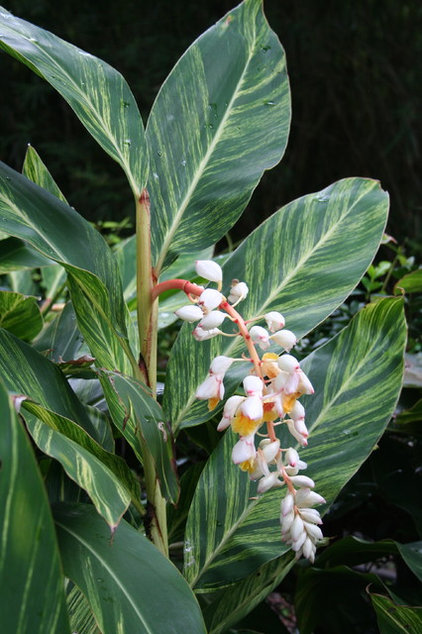 Add to ideabook
Gingers
Add to ideabook
Gingers(Alpinia, Hedychium,Curcuma etc.)
If the exotic blooms of gingers don't get you, their quintessentially tropical-looking foliage will. Plant variegated shell ginger(Alpinia zerumbet'Variegata') for its gold and green pinstriped leaves, and enjoy its shell-like blooms in areas where it rarely freezes. These plants brighten sahdy Gainesville landscaping with their yellow leaves and tropical flavor.
For instant gratification, plant Curcuma gingers such as Siam tulips(Curcuma alismatifolia, zones 8 to 11) for blooms just one to two months after the leaves first appear.Turmeric (Curcuma longa, zones 7b to 11) is also attractive but is most notable for its edible and nutritious roots. If you like fragrance, give butterfly ginger (Hedychium coronarium, zones 7b to 11) a try. Its white blooms have a sweet and spicy smell that resembles that of gardenias. This plant regularly is seen in local botanical gardens and has won Gainesville landscape plant of the month several times.
USDA zones: 7b to 11
Water and soil requirements: Rich, well-drained soil with ample moisture
Light requirement: Full to partial shade
Mature size: Varies; those listed here usually do not exceed 5 feet tall
Bloom time: Varies, but usually in summer
Planting tips: If growing gingers in zones 9 to 11, reduce watering in winter to allow a dormancy period.
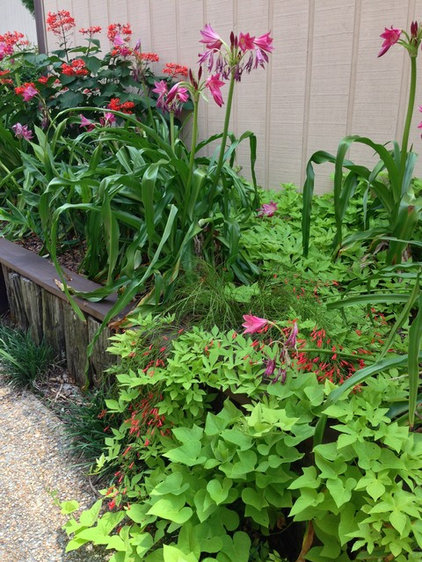 Add to ideabook
Crinums
Add to ideabook
Crinums(Crinum spp)
There's an old saying that you can't kill a crinum, and many gardeners will attest to that claim, since well-established clumps planted in old gardens have been known to live for decades, possibly longer. The crinum that's hardiest to cold is appropriately named the hardy crinum (Crinum bulbispermum, zones 5 to 11); it's worth growing not only for its pink flowers, but also for its twisted grayish-green foliage.
'Ellen Bosanquet'(Crinum 'Ellen Bosanquet', zones 6b to 11) is an old Southern favorite with untidily floppy leaves and spicy, fragrant pink blooms. Gardeners in the tropics are no doubt familiar with the ridiculously large grand crinum (Crinum asiaticum, zones 9 to 11), which reaches 6 feet tall and produces many sizable spidery white flowers. When planting this in your Gainesville lawn, make sure to give it room grow to it's full potential - otherwise you'll be doing a new landscape design around it's larger size, especially if you plant it too close to your Gainesville lawn.
USDA zones: 6 to 11
Water and soil requirements: Most crinums tolerate a wide range of conditions.
Light requirement: Full shade to full sun
Mature size: 1 to 6 feet tall
Bloom time: Varies
Planting tips: Killing a crinum is much harder than keeping one alive, but they look best when old leaves are removed.
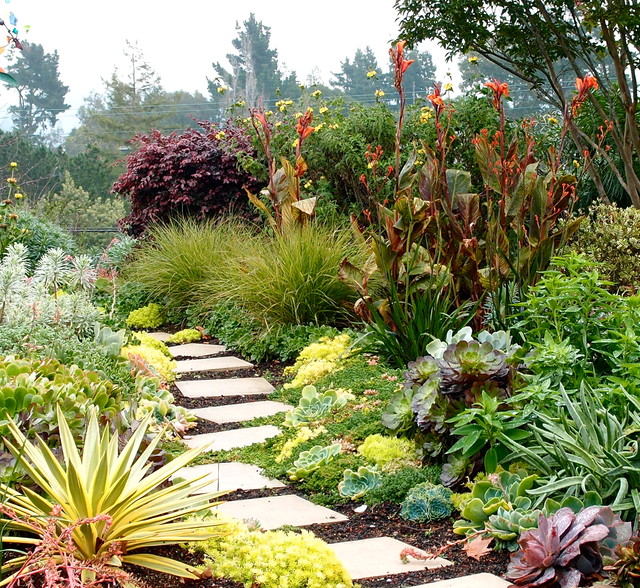 Add to ideabook
by Derviss Design
Canna
Add to ideabook
by Derviss Design
Canna (Canna spp)
Cannas quickly add height to a garden in mere months, making them ideal tropical plants for temperate climates with shorter summers. Plant them en masse at the back of garden beds to form a tantalizing backdrop or use them singly as thrillers in container plantings. In modern garden designs, their minimalist upright leaves fit right in.
Phaison (Canna 'Phaison', zones 7b to 11) is also marketed as Tropicanna and is pretty hard to miss with intensely colored leaves with stripes of purple, orange and deep green. Australia(Canna 'Australia', zones 7b to 10) has jet-black leaves and burning-red flowers.
USDA zones: 7 to 11
Water and soil requirements: Cannas perform best with rich, well-drained soil and regular watering. Many tolerate standing water.
Light requirement: Partial to full sun
Mature size: Available in many heights, from 1 to 10 feet tall
Bloom time: Summer through fall
Planting tips: Do not purchase virused plants with streaked and pale foliage; rolled leaves are caused by canna leaf roller and are best treated by cutting the affected stems to the ground.
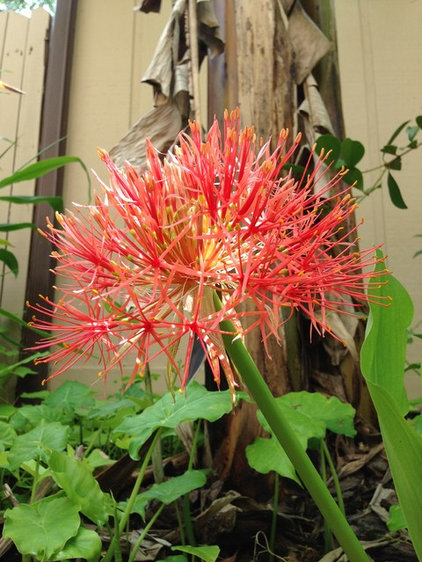 Add to ideabook
Other Tropical Bulbs
Add to ideabook
Other Tropical BulbsThe bulbs listed above sure have a lot of presence in the garden, but if you're looking for something a little more down-to-earth, grow some of these smaller standouts.
Blood lily (Haemanthus multiflorus, zones 8b to 11) is perfect for those who think they've seen it all. Just when you least expect it, June to be exact, you'll notice grapefruit-size fireworks going off in your garden when the blooms emerge on leafless stalks. The effect is magical.
Rain lilies (Zephyranthes,Habranthus spp, zones 7 to 11) have a similar effect and bloom sporadically throughout the year with trumpet-shape flowers ranging from white to yellow and pink.
Caladiums (Caladium bicolor, zones 9b to 11) are quite popular for their harlequin patterns of veins, dapples and spots in pink, green, red and white. To get more blooms, just gouge the growing point of the corms after digging them up.
 Add to ideabook
by Peter Raarup Landscape Design
Designing with tropical bulbs. When placing tropical bulbs in your Gainesville landscape, don't hesitate to pick up a few extra plants. After all, these plants don't skimp on the impact, so why would you want them to look like an afterthought? It's true that a single caladium poking out of a shade planting might evoke a feeling of whimsy, but three planted together for a mound of heart-stopping foliage becomes a focal point. Since tropical bulbs do tend to multiply, a single plant just looks unnatural anyway. The sizes of tropical bulbs vary considerably, but generally speaking they look best when surrounded by a mass of finely textured plants in your landscape.
Add to ideabook
by Peter Raarup Landscape Design
Designing with tropical bulbs. When placing tropical bulbs in your Gainesville landscape, don't hesitate to pick up a few extra plants. After all, these plants don't skimp on the impact, so why would you want them to look like an afterthought? It's true that a single caladium poking out of a shade planting might evoke a feeling of whimsy, but three planted together for a mound of heart-stopping foliage becomes a focal point. Since tropical bulbs do tend to multiply, a single plant just looks unnatural anyway. The sizes of tropical bulbs vary considerably, but generally speaking they look best when surrounded by a mass of finely textured plants in your landscape.


